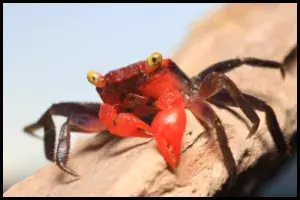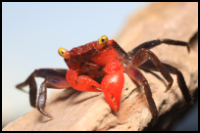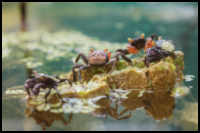



Quick Care Details (Table)
| Livestock Characteristics | Value |
|---|---|
| Care Level | Moderate |
| Temperament | Peaceful |
| Diet | Omnivore |
| Maximum Size | 1.5 inches (3.8 cm) |
| Minimum Tank Size | 10 Gallons |
| Plant Safe | Yes |
| Temperature Range | 72-82°F (22-28°C) |
| PH Range | 6.5-7.5 |
| KH Range | 3-8 dKH |
| GH Range | 6-12 dGH |
Species Specific Categories
Helpful Video
Care Details
Aquascape: Red Vampire Crabs (Geosesarma hagen) prefer a setup with both land and water areas. Use driftwood, rocks, and live plants like mosses to create hiding spots and climbing surfaces.
Substrate: A mix of coconut fiber, peat moss, and soil works well to maintain humidity and allow burrowing.
Disease Prevention: Maintain clean water conditions and ensure proper humidity levels to prevent fungal infections and shell rot.
Filtration: Gentle filtration with a sponge filter is ideal to maintain water quality without creating strong currents that can disturb the crabs.
Lighting: Low to moderate lighting is sufficient; provide a day-night cycle to mimic natural conditions.
Water Flow: Minimal water flow is best; adjust filtration to avoid strong currents.
Hardiness: These crabs are hardy if provided with suitable habitat conditions and proper care.
Acclimation: Slowly acclimate them to new water parameters or habitat changes to reduce stress.
Expected Lifespan: With proper care, Red Vampire Crabs can live up to 2-3 years in captivity.
Special Requirements: Provide access to both dry land and water areas; maintain high humidity levels (around 70-80%) in the enclosure.
Temperament and Behavior
Behavior: These crabs are generally active during the night and may hide during the day. They are known to climb and explore their environment, especially if provided with plenty of hiding spots.
Breeding: Breeding in captivity can occur under suitable conditions, with females carrying eggs under their abdomens until they hatch.
Aggression: Red Vampire Crabs can be territorial, especially towards their own species and similar-looking species. Males can also be aggressive during mating.
Tankmates Compatibility: Best kept in species-specific setups or with non-aggressive tankmates like small fish (tetras, rasboras), snails, or shrimp that won't compete for space.
Activity Level: They are moderately active, especially during feeding times and when exploring their environment.
Schooling or Shoaling Behavior: Solitary creatures; they do not exhibit schooling or shoaling behavior.
Plant Compatibility: They may uproot or damage delicate plants, so choose hardy species or use artificial plants in their habitat.
Diet and Nutrition
Dry Foods: Offer high-quality crab pellets or sinking shrimp pellets as a staple diet.
Frozen Foods: They enjoy occasional treats of frozen bloodworms, brine shrimp, or daphnia.
Live Foods: Live foods like small insects, worms, or feeder shrimp are eagerly accepted and help mimic their natural diet.
Vegetables: Fresh vegetables such as spinach, zucchini, or cucumber should be blanched and offered occasionally for fiber and variety.
Algae: They will nibble on algae in the tank; ensure there's some available or supplement with algae wafers.
Feeding Schedule: Feed once a day, offering an amount they can consume within a few hours. Remove any uneaten food to maintain water quality.
Supplemental Foods: Provide occasional treats like fruits (e.g., apples, grapes) in small amounts as a supplement to their diet.
Tank Parameters
Tank size: A minimum of 10 gallons for a small group of crabs, with additional space for climbing and hiding spots.
Tank Length and Measurements: Provide a tank that is long enough to accommodate their active exploration and climbing behavior.
Water Temperature: Keep the water temperature between 75-82°F (24-28°C) to mimic their native tropical habitat.
pH (Acidity/Alkalinity): Maintain a slightly acidic to neutral pH range of 6.5-7.5.
KH (Carbonate Hardness): Keep the carbonate hardness (KH) stable around 3-8 dKH.
GH (General Hardness): Maintain general hardness (GH) around 5-15 dGH to support their overall health.
Hardiness: Red Vampire Crabs are hardy if provided with stable water parameters and suitable habitat conditions.
Nitrate (NO3) levels: Keep nitrate levels low, ideally below 20 ppm, through regular water changes and proper filtration.
History, Popularity, History and Species Variety Details
History, Popularity and Natural Habitat:
History: Red Vampire Crabs (Geosesarma hagen) are native to freshwater habitats in Indonesia, particularly in swampy areas near rivers and streams. They have gained popularity in the aquarium hobby due to their unique appearance and interesting behaviors. Initially discovered in the late 19th century, they were later introduced to the aquarium trade, where they have become sought after by enthusiasts for their vibrant colors and engaging personalities.
Popularity: Red Vampire Crabs have become increasingly popular among aquarium enthusiasts for their striking red coloration, active behavior, and relatively easy care requirements. They are valued for their ability to live both on land and in water, making them fascinating additions to aquascapes and paludarium setups. Their popularity continues to grow as more hobbyists appreciate their unique attributes and suitability for smaller aquariums.
Natural Habitat: In their natural habitat, Red Vampire Crabs inhabit moist, swampy areas close to freshwater sources in Indonesia. They are adapted to a mix of land and water, spending time both submerged and on land among leaf litter, rocks, and vegetation. These crabs are accustomed to fluctuating water levels and moderate temperatures, typically found in tropical regions with dense vegetation and ample hiding spots.
Similar and Variations of the Species:
- Geosesarma dennerle: Similar in appearance and care requirements, often featuring variations in coloration and markings.
- Geosesarma species (various): Other species within the Geosesarma genus share similar habits and environmental preferences, varying in color and behavior across different regions.
Frequently Asked Questions
Do Red Vampire Crabs molt?
Yes, they shed their exoskeletons as they grow. Provide hiding spots and a stable environment during molting periods.
Can Red Vampire Crabs escape from the tank?
They are skilled climbers, so ensure your tank has a secure lid to prevent escapes.
Do Red Vampire Crabs need a heater in their tank?
Yes, they require warm water temperatures between 75-82°F (24-28°C) to stay healthy and active.
Are Red Vampire Crabs aggressive towards other tankmates?
They can be territorial, especially with their own kind or similar-looking species. Choosing compatible tankmates is crucial.
Can Red Vampire Crabs live entirely underwater?
No, they need access to both land and water to thrive. They enjoy climbing and exploring above the waterline.
Can Red Vampire Crabs be kept with fish?
Yes, choose small, peaceful fish as tankmates to minimize aggression and competition for space.

